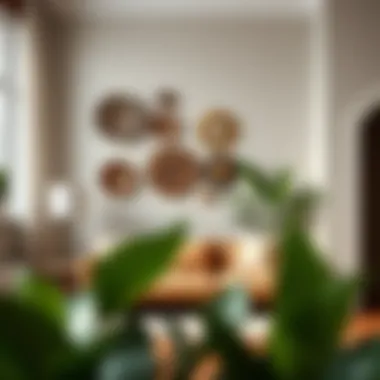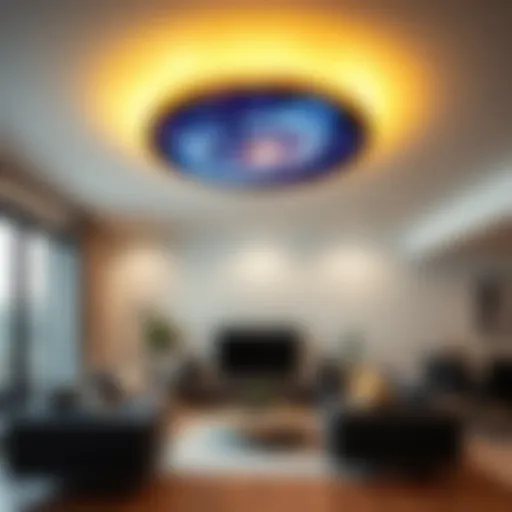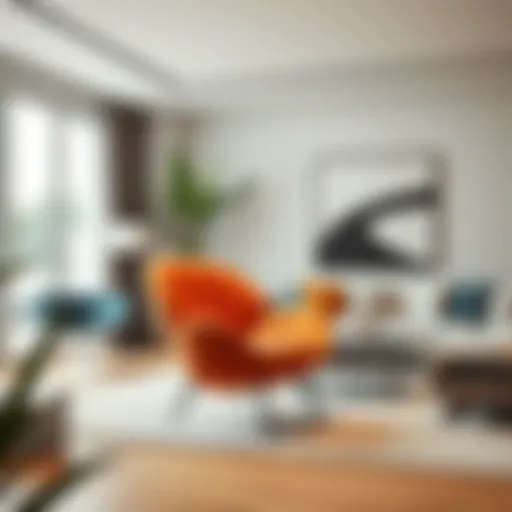Elevate Your Space: At-Home Wall Decor Insights


Intro
Creating an inviting and aesthetically pleasing environment in our homes is more than just an afterthought; it plays a crucial role in our overall well-being. Wall decor, often underestimated, can be a game-changer in how we experience our living spaces. It's not only about slapping a coat of paint on the walls or throwing up a couple of prints. Rather, it encompasses a variety of styles, materials, and emotional factors that together craft the essence of a room.
Homeowners, designers, and DIY enthusiasts constantly seek insights into wall decoration tactics. This article digs into the different aspects of at-home wall decor, offering a blend of both modern trends and timeless wisdom that resonates with every decorator’s touch. We’ll unpack the influence wall art has on our mood, discuss how to meld creativity with functionality, and explore best practices for each room in your abode. Whether you’re a novice venturing into your first home or a seasoned designer, there’s likely something here that will pique your interest and enhance your approach to creating striking walls.
By the end of this read, you should have a grasp of current design trends, practical installation techniques, and a clearer pathway to expressing your unique style throughout your home. It’s all about making those walls speak by transforming blank spaces into veritable canvases that showcase personality, warmth, and functionality.
Understanding Wall Decor
Wall decor plays a significant role in defining the ambiance of any living space. It’s not just about putting up a few pictures or hanging a fancy clock; it’s a detailed expression of personal style and emotional touch. A room’s walls can transform from mundane surfaces into stories that reflect who lives there. In the context of this article, understanding wall decor encompasses various styles, psychological effects, functional aspects, and the heart of personal expression when tailored specifically to a homeowner's taste.
Incorporating well-considered wall decor not only enhances aesthetics but can also influence the mood within the space. A bare wall often feels cold and uninviting, while carefully selected pieces can provide warmth and comfort, making a home feel lived-in and loved. It’s essential to see these decorations as extensions of ourselves, bridging the gap between interior design principles and personal narratives.
The Role of Wall Decor
Wall decor serves several roles beyond mere decoration. Here are a few key aspects to consider:
- Aesthetic Enhancement: Attractive wall art improves the visual appeal of a room, drawing eyes to certain areas.
- Personal Storytelling: Each piece can express stories, values, or moments that resonate with the inhabitants.
- Functional Utility: Art can also serve a significant function; for example, shelving units or clipboards can house essential items while looking stylish.
- Setting Mood and Atmosphere: Colors and styles of wall art can influence how a space feels—soft, calming hues can relax, while bold colors can energize.
Understanding the role that wall decor plays allows homeowners to make more thoughtful decisions, ultimately leading to a harmonious environment.
Psychological Impact of Decor
The psychological effects of wall decor are often overlooked, yet they hold remarkable power over our feelings and behaviors in a space. When selecting wall art, consider the following:
- Visual Tranquility: Artwork with serene landscapes or harmonious designs can promote relaxation and decrease stress levels.
- Boosting Creativity: Bright, playful designs often stimulate creativity, making them ideal for spaces like home offices or creative nooks.
- Cultural Connections: Decor that reflects cultural backgrounds can offer comfort and connection, fostering a sense of belonging.
- Mood Influencers: Different colors elicit various emotional reactions; for instance, blue can evoke feelings of calm, while yellow may bring cheerfulness.
"Art is not what you see, but what you make others see." — Edgar Degas
In summary, wall decor is not simply a decorative choice but a pivotal element affecting our psychological landscape, influencing emotions and setting the tone in our homes. By understanding these layers of meaning behind wall decor, homeowners can create spaces that nurture and inspire.
Styles of Wall Decor
When it comes to transforming spaces within a home, the style of wall decor becomes a central theme. It's like the icing on the cake; without it, even the most well-designed rooms can feel incomplete or lackluster. Choosing the right style allows homeowners and decorators alike to express themselves, establish moods, and create a cohesive look that reflects personal taste.
Different styles of wall decor not only enhance the visual appeal but also serve as a medium of personal expression. For instance, a minimalist approach can evoke a sense of calm and order, while an eclectic mix might showcase a vibrant personality, bursting with stories and emotions. This section delves into the nuances of various wall decor styles, helping readers make informed choices that align with their vision and preferences.
Minimalist Approaches
Less is More – that's the creed of minimalism. In wall decor, this translates to simplicity, clean lines, and a focus on space rather than clutter. A minimalist approach often features monochromatic color schemes, large unframed art pieces, or sculptural elements that have little to no embellishments.
For homeowners wanting to declutter their minds as well as their spaces, a minimal aesthetic might be the way to go. Consider using oversized canvases with soft hues to make a statement while keeping distractions at bay. This style emphasizes the quality of individual pieces rather than the quantity, allowing a few well-placed items to breathe and resonate.
Eclectic Mixes
Embracing the unexpected, eclectic wall decor combines various styles, colors, and materials into a visually rich tapestry. Here, the sky’s the limit. You could pair a vintage flying pig art piece with contemporary black-and-white photography, highlighting the joys of contrast. Many homeowners find this style liberating, as it encourages them to be adventurous and express unique cultural influences and personal memories.
Choosing an eclectic mix also means you can bring in artifacts from travels or even DIY projects. One important consideration is balance; without it, the assortment can easily shift from artistic to chaotic. Aim for a visual connection, whether through color, frame style, or the materials used. It’s about catching the eye without overwhelming the senses.
Traditional Aesthetics
For many, traditional wall decor evokes a sense of nostalgia, intertwining historical significance with comfort. This style often highlights classic design elements such as ornate frames, landscapes, or traditional still-life paintings. Rich colors and textures, often complemented by vintage furniture or architectural features, create a homely environment rife with warmth.
Incorporating traditional aesthetics means paying attention to detail. Vintage reproductions or heirlooms can add character and depth to your decor. Wall tapestries or framed prints can create focal points while harkening back to eras gone by. The challenge lies in maintaining contemporary functionality without overpowering the intimate feel of tradition.
Contemporary Trends
Staying on the pulse of what’s fresh, contemporary wall decor often incorporates bold colors, innovative materials, and creative installations. The use of digital art displays, for instance, is becoming an increasingly popular way to merge technology with aesthetics, allowing homeowners to change their decor in a snap.
Art doesn't have to be static; think artistic wall panels, mixed media installations, or even living walls with greenery. Contemporary collectives like artists showcasing digital technology are redefining spaces, bringing art to life. This approach is not just about sticking to trends but weaving a narrative that resonates with the current cultural moment.
As trends evolve, the contemporary style adapts, leaning heavily on sustainability and ethical practices, bringing a conscience to aesthetics. In this exploration of dynamic styles of wall decor, we understand that choice is paramount; recognize your individuality and allow it to flourish in the form of your walls.
Materials for Wall Art
When it comes to wall decor, the choice of materials plays a critical role in shaping the aesthetics and functionality of the space. Each material holds its unique qualities, contributing to the overall atmosphere and visual narrative of a room. The right selection can transform an ordinary wall into a focal point, allowing for personal expression and creativity.
- Durability: Some materials withstand the test of time better than others. For instance, canvas and paint can last for decades if cared for, while textiles may require more maintenance.
- Cost-effectiveness: Different materials come with various price tags. It’s essential to balance budget with the desired outcome, ensuring you get the best bang for your buck without compromising on quality.
- Ease of Installation: Certain materials can be cumbersome to install, while others allow for a straightforward DIY approach. Understanding these factors helps in planning and execution.
Ultimately, these elements not only affect the visual appeal but also the emotional connection one has with their decor. Let's dive into the specifics of various materials that can be utilized in creating striking wall art.
Canvas and Paint
Canvas and paint are perhaps the most traditional forms of wall art, and for good reason. They provide a versatile medium that can be tailored to any personal style or aesthetic.
- Texture: Canvas materials offer a unique texture that can enhance the overall appearance of a painting. You can select between stretch canvas or canvas boards, each presenting its distinct feel.
- Colors: The application of paint on canvas allows for both intricate details and bold expressions. Whether it’s a soft pastel or a vibrant red-orange, paint can evoke emotions and set a mood.
- Creativity: Painting on canvas encourages one to experiment. You can start from scratch or use it to frame a particular message or theme that resonates.


In addition, canvas art tends to be lightweight, making it easy to hang, and can even be framed for added dimension.
Framed Art
Framed art brings a polished finish to any room. The physical boundaries that a frame provides can create a sense of completeness.
- Unified Look: Utilizing matching frames can bring a cohesive look to a gallery wall. It helps in guiding the eye across different art pieces, enhancing their distinctiveness without overwhelming the viewer.
- Protection: Frames not only enhance the visual appeal but also protect artworks from dust, dirt, and UV rays, prolonging their life. Especially important for photographs or delicate pieces.
- Variety: The diversity in frame styles—from ornate to sleek—enables a homeowner to tailor their decor as per preference, allowing flexibility in showcasing art.
Selecting the right frame can elevate simple prints into something striking.
Wall Stickers and Decals
Wall stickers offer an innovative way to make a significant impact without the long-term commitment of paint or nails. They are particularly popular among renters and those looking for temporary decor solutions.
- Ease of Use: Most wall stickers are easy to apply and remove, which makes them a favorite for those who frequently change their decor. A simple peel-and-stick can transform a dull wall in a matter of minutes.
- Variety of Designs: From whimsical to minimalist, the designs available can cater to various tastes. Customization is also an option, allowing for personalized crests or sayings.
- Affordability: Budget-friendly, wall stickers can freshen up a room without causing a dent in your wallet, making them a go-to for DIY enthusiasts.
They are especially great for children's rooms, where playful designs can enhance the room's personality.
Textiles and Tapestries
Textiles and tapestries introduce warmth and comfort to a space. They can soften hard walls and create a cozy atmosphere that invites relaxation.
- Fabric Variety: From cotton to wool, the choice of fabric impacts the feel of the space. Lighter materials can brighten a room, while heavier fabrics can evoke a sense of coziness.
- Cultural Touch: Tapestries often carry significant cultural connotations, telling stories through imagery or patterns. They provide a unique way to express one's heritage or aesthetic vibe.
- Insulation: Besides their aesthetic contributions, fabrics can help with sound insulation, reducing echoes in larger living spaces.
Hanging a tapestry behind a bed can add character, serving as a stunning headboard substitute.
Sculptural Elements
Sculptural wall decor has gained traction recently, as it adds depth and interest to flat surfaces. These three-dimensional pieces break the monotony of traditional wall art.
- Visual Interest: Sculptures can create shadows and change the mood of a space based on the light. They draw the eye and invite touch, unlike traditional wall art.
- Material Exploration: From metal to wood, the variety of materials used in sculptures is extensive, allowing for vast thematic explorations—from modern to rustic.
- Versatility: Sculptures can stand alone or be combined with other decor elements for rich layering, making them suitable for various internal styles.
A large wall sculpture can become a conversation starter, making your living room a hub for visitors.
Regardless of the material selected, the key is to ensure it speaks to you and complements your overall vision for the space. Each piece, whether temporary or permanent, has the power to narrate your personal story within the confines of your home.
Techniques for Arrangement
Arranging wall decor is not just about hanging pictures or putting up shelves; it’s about creating a cohesive visual narrative that draws the eye and harmonizes the space. This section dives into the different techniques you can embrace to make your walls speak volumes about your style and personality, while also considering the overall aura of your home.
Gallery Walls
A gallery wall offers a unique opportunity to create a dynamic focal point in any room. This collage-like arrangement can include a variety of elements such as framed art, photographs, mirrors, and even 3D objects. What makes gallery walls appealing is their ability to showcase personal stories and experiences, creating a rich tapestry of your life.
When crafting your gallery wall, consider:
- Themed Collections: Group items by color, subject, or style to create a sense of unity.
- Layout Planning: Before nailing anything to the wall, lay the pieces out on the floor. That helps visualize spacing and composition.
- Varying Sizes: Mix larger pieces with smaller ones, adding depth and interest to the arrangement. Don't be afraid to experiment with different shapes and sizes.
“Art is not what you see, but what you make others see.” – Edgar Degas
Symmetrical vs. Asymmetrical Layouts
Choosing between a symmetrical or asymmetrical arrangement is pivotal, as each brings a different energy to a space. A symmetrical layout tends to exude a formal and organized vibe, often found in more traditional or minimalist settings. Think of classic portraits hanging evenly spaced either side of a central piece. This type of balance can create a sense of calm and tranquility in a room.
On the other hand, an asymmetrical layout presents a more casual yet visually engaging approach. It allows for creative freedom, encouraging the use of varied elements that catch the eye. This technique can be particularly effective in a modern or eclectic home where the aim is to stimulate interest through irregularity.
When implementing these layouts, consider:
- Visual Weight: Pay attention to how heavy or light each piece appears. Ensure balance, even if it is not symmetrical.
- The Environment: Match the layout to the style of the room. Formal spaces might benefit from symmetry, whereas casual areas thrive on asymmetry.
Layering Decor Elements
Layering decor elements on your walls allows you to add texture and depth to your design. This technique involves combining different materials, colors, and styles to create a multidimensional look. It might include mixing framed photographs with textiles like wall hangings or decorative plates.
Here are some tips to successfully layer:
- Start with a Base: Use a large canvas or textured wall treatment as a backdrop for your decor.
- Mix Materials: Combine elements like wood, metal, and fabric. This variety gives a more robust feel to the decor.
- Overlap Strategically: Don’t shy away from overlapping pieces, as it can create a playful interaction between items.
Layering can also highlight themes or stories behind your decor, making it all the more personal. It transforms a simple wall into an experience that invites viewers to explore the nuances of your style.
In summary, being creative with arrangement techniques is essential in transforming walls from mere surfaces to statements of personality and purpose. Each method discussed here allows homeowners, designers, and DIY enthusiasts to bring their ideas to life, ensuring that every wall tells its own unique story.
Functional Wall Decor
When contemplating wall decor, one might typically envision paintings or framed photographs. However, functional wall decor goes beyond mere aesthetics, blending practicality with creativity. This approach addresses the realities of modern living where space can be at a premium, especially in urban environments. Taking into account the importance of functionality, it's vital to incorporate decor elements that serve a purpose, rather than merely line the walls with decorative pieces.
Utilizing wall space efficiently can add layers to the decor while enhancing its usability. The benefits are manifold: functional wall decor helps to prevent clutter, can express one's individual style in a distinctive way, and increases the overall utility of the living space. Ensuring that decoration is not just ornamental but serves a purpose can lead to a more thoughtful and well-planned living environment that works for its occupants.
Incorporating Storage Solutions


Wall-mounted storage solutions have become a go-to for homeowners and designers alike, particularly in areas where floor space is limited. Floating shelves, for instance, not only display decor items beautifully but can also hold books, plants, and other personal treasures. This dual-purpose design element allows for effective use of vertical space. Using decorative baskets or boxes can further enhance the aesthetic while keeping clutter tucked away.
Considerations for effective storage solutions:
- Material Choice: Opt for materials that resonate with your home's aesthetic. Wood or metal can add character.
- Size: Ensure the shelves are proportionate to the wall size; oversized shelves may overwhelm a small room.
- Accessibility: Place items that you use more frequently within easy reach and reserve higher shelves for less-used items or purely decorative elements.
Utilizing hooks or pegboards can also serve as functional decor, offering a space to display and organize everyday items, from tools to accessories. The key is to find a balance between the beauty and practicality of items on display.
Functional Artwork
Art isn't just for looking at anymore; it can serve several practical functions without sacrificing style. Functional artwork includes pieces like wall clocks, magnetic boards, or even chalkboards that double as statement pieces. These items allow the introduction of practical features into a decor scheme, ensuring that tremendous thought is given to both form and utility.
When selecting functional artwork, consider:
- Theme Alignment: The artwork should align with the existing decor theme or color palette, making it feel like a cohesive part of the entire room.
- Purposefulness: Choose artworks that solve specific problems, like a cork board that can also serve as a striking visual element.
- Creativity: Combine different art forms, such as a painting with built-in shelving, creating a unique focal point that stands out while remaining useful.
By merging form with function, homeowners can elevate their surroundings into a space that reflects personality and purpose, leading to a harmonious balance in decor.
Personal Expression in Decor
Personal expression in wall decor goes beyond mere aesthetics; it's a reflection of oneself, a narrative drawn upon personal experiences, cultural backgrounds, and individual preferences. This aspect of decor allows homeowners to present their uniqueness in a tangible manner. When you think about how walls transform spaces, consider that they also encapsulate stories and evoke emotions. It’s a canvas that communicates to visitors who you are and what matters to you. Here are a few key points that underscore the importance of personal expression:
- Identity: Wall decor is often a direct representation of your interests, beliefs, and experiences. This could be family portraits, artworks from local artisans, or a collection of travel mementos.
- Atmosphere: The elements you choose modify the mood of a room. A bright, colorful piece can invigorate a space while a serene landscape may promote peace and calm.
- Engagement: Personalized decor invites conversation and engagement. Guests often appreciate the time and thought that goes into curating a space that reflects one’s personality.
By focusing on personal expression, you create a home that is not only visually appealing but also resonant with life and memory.
Cultural Influences
The beauty of wall decor stems from its ability to encompass various cultural influences. Around the globe, decor choices are steeped in tradition and each culture carries its own unique flair. For instance, choose to hang a batik or a woven textile from Indonesia, and instantly, the room takes on stories of rich heritage and craftsmanship. Utilizing objects that resonate with your cultural background or that of others can enhance understanding and appreciation of different histories and crafts.
Additionally, integrating elements from various cultures can lead to a rich, layered aesthetic—think Moroccan lamps juxtaposed against Scandinavian minimalism. Be mindful, however, that when incorporating cultural elements, it’s essential to do so respectfully and authentically. Taking the time to learn about the significance of these pieces can ensure that they are represented meaningfully in your decor.
Family and Memories
Family and memories are arguably at the core of many homes. They form the backbone of your life experiences and echo the stories that shape personal identity. Hanging family photographs or framed pieces that celebrate significant moments can create a visual timeline on your walls.
Choose images that evoke nostalgia, such as a wedding snapshot or a candid capture of family vacations. These can serve as gentle reminders of love and belonging. Alternatively, one might consider creating a memory wall—featuring items like drawings from children or postcards collected during travels—transforming walls into a dynamic showcase of personal history.
"Decor is a serial storyteller; with each piece, a new chapter unfolds."
Balancing memory with style can create an inviting atmosphere. The decision to incorporate these elements is subjective, yet profoundly impactful. It offers not just decoration, but a signpost of your journey through life, fostering connection not only within the household but also with guests who visit.
In summary, the interplay of cultural influences and family memories within personal decor serves to foster connections—both personal and communal. Each item tells a story, inviting engagement, reflection, and appreciation of diverse backgrounds and cherished moments in your life.
Sustainable Practices in Wall Decor
As the world shifts its focus toward sustainability, the realm of interior design is no exception. Implementing sustainable practices in wall decor not only reflects a commitment to the environment but also enriches the living space with a unique personal touch. Homeowners, designers, and DIY enthusiasts can contribute to reducing their ecological footprint through thoughtful choices in materials and methods. The impact of decor goes beyond aesthetic pleasure; it holds an intrinsic link to environmental well-being, prompting us to think twice about the adornments on our walls.
Eco-Friendly Materials
Using eco-friendly materials is crucial in achieving sustainable wall decor. These materials are typically sourced responsibly, minimizing environmental impact during production and shipping. For instance, opting for organic cotton or linen for wall hangings ensures that harmful pesticides and chemicals are absent from the creation process. Natural dyes derived from plants can further enhance these textiles without adding toxic elements to your space.
Benefits of Eco-Friendly Materials:
- Healthier Indoor Air Quality: Traditional paints and adhesives often contain volatile organic compounds (VOCs), which can adversely affect indoor air quality. Eco-friendly alternatives, like water-based paints with no VOCs, offer a safer atmosphere.
- Durability: Many sustainable materials tend to be more resilient, providing long-lasting decor that saves both money and resources in the long run.
- Aesthetic Appeal: Materials such as reclaimed wood and bamboo not only contribute to sustainability but also bring character and a unique story to your space.
Reupcycling Decor
Reupcycling decor stands as another significant practice within sustainable wall decoration. This involves transforming used items into new decor pieces, which diverts waste from landfills and fosters creativity. It’s a method that requires little more than a keen eye and some effort to breathe new life into old objects.
Some practical ideas for reupcycling include:
- Old Frames as Art: Take mismatched frames and paint them to create a cohesive gallery wall. You can fill them with family photos or even fabric swatches for a pop of color.
- Book Pages as Wall Art: Old books that have seen better days can provide a literary touch when you frame their pages. This adds a touch of personal history without purchasing new materials.
- Furniture Repurposing: Wooden pallets or old crates can be transformed into unique shelving units that double as wall decor, supporting not just aesthetics but functionality.
The beauty of reupcycling is that every piece tells a story—your wall decor can reflect your history, creativity, and values in sustainability.
By embracing eco-friendly materials and exploring reupcycling decor, creators can make informed choices that celebrate both the environment and their aesthetic preferences. These practices form not just a trend, but a critical movement towards more mindful living.
Cohesion with Overall Design
Creating a harmonious home involves more than just slapping a few decorations on the wall. Cohesion in wall decor plays a vital role in uniting various elements of a living space, making it feel like a cohesive environment rather than a patchwork quilt of unrelated pieces. Each decor choice should complement the overall design, thus enhancing the overall aesthetic experience.
The importance of considering cohesion lies in its multifaceted benefits:
- Visual Harmony: Cohesive designs create a sense of balance and peace. When colors, patterns, and textures align, they generate an appealing visual flow that guides the eye throughout the space.
- Thematic Consistency: A strong theme—a coastal vibe, modern minimalism, or rustic charm—invites the alignment of wall decor with furniture and other elements. This kind of consistency helps in manifesting a distinctive personality and ambiance in your home.
- Enhanced Functionality: Cohesion does not only apply to aesthetics; it includes functionality as well. For example, wall-mounted storage solutions can blend seamlessly with artistic elements if they share a common color palette or materials.
In summary, the decorations hanging on your walls should not exist in a vacuum. Instead, they ought to be part of a larger conversation with other decor items, creating a narrative that reflects your individual style and intentions.


Color Schemes and Themes
Color schemes are fundamental in establishing cohesion. Think of your walls as the canvas of your home. Choosing a palette that resonates with your style is crucial. When picking colors for wall decor, consider the following points:
- Monochromatic Schemes: This approach uses different shades and tints of a single color. It’s understated and creates a clean, refined look. For example, varying shades of blue can create a calming feel, perfect for bedrooms or relaxing spaces.
- Complementary Colors: Using opposite colors on the color wheel adds vibrancy and a sense of energy to a room. If your furnishings are warm, consider cooler tones in wall art or vice versa.
- Accent Colors and Themes: Select one or two accent colors to bring pops of visual intrigue in your decor elements. Emphasizing a consistent theme—such as botanical themes with greens and earthy hues—results in a unified aesthetic.
Flow Between Spaces
The flow between spaces is another critical factor in ensuring cohesion in decor. An open floor plan offers challenges and opportunities. Walls in different rooms should speak to one another. Here’s how you can achieve that:
- Transition Colors: Carrying a primary color from one room to the next helps maintain visual continuity while subtly guiding visitors through your home.
- Common Elements: Materials and textures that repeat across spaces, like wooden frames or metallic accents, instill a sense of fluidity throughout each area.
- Visual Pathways: Consider how art and decor elements are viewed from different angles. Ideally, pieces should lead the eye naturally from one space to the next; for example, aligning a gallery wall in the hallway that leads into a living room.
Maintaining cohesion between spaces elevates the overall experience, contributing to a cohesive atmosphere that feels intentional and well thought out.
Room-Specific Considerations
When it comes to at-home wall decor, simply choosing beautiful artwork or trendy pieces is not enough. Understanding room-specific considerations is paramount. Each area of your home functions differently, serving various purposes and hosting distinct atmospheres. To craft an engaging environment, it’s essential to tailor wall decor to fit these unique characteristics.
Focusing on room-specific considerations allows you to amplify the chosen style while enhancing the functionality of each space. Not only does it cultivate a visual narrative, but it also optimizes the emotional resonance of the room. Here’s a rundown of the different spaces and what to keep in mind as you decorate.
Living Rooms
The living room often serves as the heart of the home—a gathering place for family and friends. This is where storytelling happens, laughter resonates, and memories unfold. For this central hub, the decor should promote warmth and inclusivity. Consider incorporating larger pieces of art or engaging wall galleries that can become conversation starters.
- Scale is Key: Ensure that the size of the decor complements the room’s dimensions. A very large wall needs a substantial piece, while smaller spaces may benefit from a collection of intimate artworks.
- Color Palette Cohesion: The colors you choose can profoundly impact the room’s mood. Warmer colors often make a space feel more inviting, whereas cooler tones may lend a more serene atmosphere.
- Arrangement: Think about how your wall decor interacts with existing furniture. A well-placed piece can draw the eye and create cohesion in the layout.
Bedrooms
The bedroom is a sanctuary for relaxing and restoring energy. Therefore, decor choices here should reflect comfort and tranquility. Artworks should evoke positivity and peace, making the space a soothing refuge.
- Personal Touches: Incorporate personal photographs, quotes, or pieces that resonate with you. This makes the space feel uniquely yours, promoting restful nights.
- Soft Textiles: Tapestries or fabric-based wall hangings can soften the space, add warmth, and serve as cushions for sound, enhancing the overall acoustics.
- Mood Lighting: Consider adding elements that play into lighting—art that pairs well with ambient light can create a serene atmosphere as you unwind.
Kitchens
Kitchens are more than just spaces for cooking; they are social hubs for families and friends. In this environment, decor should encourage both conversation and creativity.
- Functional Decor: Utilize wall-mounted shelves to display cookbooks or handmade pottery. Such pieces can be both decorative and practical.
- Inspirational Quotes: Wall art with motivational culinary quotes can inspire your inner chef while adding character to the room.
- Color Coordination: Bright, cheerful colors can energize the kitchen, so don't shy away from vivid artwork or complementary wall paint.
Home Offices
In today's remote working climate, the home office requires a delicate balance of professionalism and inspiration. Wall decor should promote focus while also allowing for personal expression.
- Create a Distinct Space: Using imagery that inspires you—whether that be landscapes, motivational sayings, or abstract art—can foster a productive environment.
- Organizational Elements: Incorporate functional wall organizers that can double as decor. Cork boards or magnetic strips can showcase important notes or reminders while blending with the aesthetic.
- Plant Life: Incorporating greenery through wall-mounted planters can bring life and freshness to a workspace.
Hallways
Hallways often go unnoticed, yet they offer a perfect canvas for creative expression. Since they are transitional spaces, wall decor here can set the stage for the experiences that lie ahead.
- Gallery Style Displays: Use hallways to display an art collection or a memorable photo series, captivating visitors as they pass through.
- Mirrors for Light: Adding mirrors can not only make the space seem larger but also reflect light, enhancing the ambiance.
- Accent Colors: A splash of bold color can make a long hallway feel more inviting and playful. Consider painting an accent wall or using patterned wallpaper.
The value of room-specific considerations can't be overstated. Tailoring your decor to fit the unique elements of each space creates an atmosphere that resonates with its purpose.
By keeping these considerations in mind, you can transform each room into a personalized haven that reflects your style while enhancing the overall function of your home.
Trends in Wall Decor
Wall decor trends are constantly evolving, and understanding these changes can elevate your home's aesthetic to new heights. These trends reflect cultural shifts, technological advancements, and evolving personal tastes, making them vital to a well-rounded approach in decorating your space. Incorporating trends allows homeowners, designers, and DIY enthusiasts not only to stay relevant but also to express their unique styles through creative means. Adapting to these trends can enhance your living space while also increasing the charm and appeal of your home. In this section, we delve into two prominent trends that have caught the eye of many: artisanal pieces and digital art displays.
Artisanal Pieces
In a world increasingly dominated by mass production, there’s been a notable swing back to handcrafted items. Artisanal pieces have gained momentum because they provide a unique, personal touch that stock items simply can't match. Not only do these pieces often serve as conversation starters, but they also embody the skill and creativity of craftsmen from various backgrounds.
Consider items like handwoven tapestries or painted ceramics that carry a story behind them. Each artisanal creation is generally made with care and thought, lending warmth and character to your walls. Furthermore, accumulating these pieces can lead to forming relationships with local artisans, encouraging a community-focused economy. By opting for such decor, you’re not just dressing up your walls; you’re also making a statement about supporting sustainable practices and celebrating diverse cultures.
Benefits of Artisanal Pieces:
- Uniqueness: No two pieces are identical, making your decor one-of-a-kind.
- Connection: They often include a narrative or a backstory, adding personal value.
- Quality: Handcrafted items are typically more durable and intricately designed than mass-produced goods.
In creating a space filled with artisanal decor, you not only beautify your walls but also cultivate an environment that reflects identity and intention.
Digital Art Displays
As technology marches on, our methods of displaying art evolve too. Digital art displays bring forth a new frontier, allowing homeowners to showcase a multitude of artworks without needing to change a single frame. These devices often enable users to load hundreds of pieces, shifting between artworks with just a tap or click. This trend caters to a modern lifestyle that thrives on immediacy and variety.
In addition to their versatility, digital displays can act as canvases for both established artists and budding creators. Social media platforms have made it easy to connect to the art world, decreasing the barriers for artists to enter and present their works. One minute you might be looking at Van Gogh, and the next, a stunning piece by a local digital artist.
Considerations for Digital Art Displays:
- Space-Saving: Great for small areas where traditional framing isn’t feasible.
- Dynamic Content: Rotate artworks based on season, mood, or simply personal preference.
- Interactive Features: Many devices allow for further customization and engagement, bridging art with technology.
Utilizing digital art displays offers an inventive way to engage with art, providing a platform where creativity knows no bounds, while also catering to your desire for change and innovation.
"In a world flooded with choices, trends emerge as a guiding light, helping us navigate the often overwhelming terrain of home decor."
Incorporating these trends into your home decor not only updates your living space but also resonates with a deeper significance related to community, technology, and personal expression. Understanding these trends and their implications can help both novices and experienced designers make informed decisions that will transform any wall into a reflection of their unique narrative.















